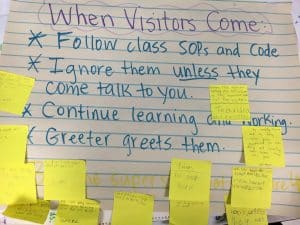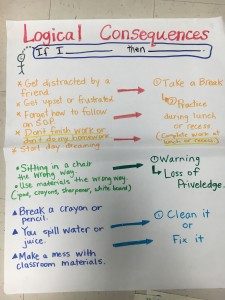Culture and Climate
CompetencyWorks Blog

/kəlCHər/
: the beliefs, customs, arts, etc., of a particular society, group, place, or time
: a way of thinking, behaving, or working that exists in a place or organization
When we identify with our culture, of course we think of norms such as clothing, language, food, and education. In addition, we hold certain beliefs and assumptions close as a part of our culture. Even though going to school seems like a natural part of childhood, there is a whole subculture within the education system that plays a huge role in a child’s life.
Students spend most of their lives in our classrooms. It is up to us, as educators, to foster a classroom culture that meets their basic needs, supports their academic learning and growth, and teaches social skills such as empathy, grit, and gratitude.
So how do we do this? We must first understand that students come to us with a concept of their own culture, which we have to acknowledge and respect. Our job is to teach them the basics for them to be successful in the culture of schools for them to be successful in all the ways we hope for them.
Of course we, as teachers, have heard that the first six weeks of school is when to really set the tone for the year and begin to “lay down the law.” In my experience, these first few weeks are very important, but it’s about establishing respect, trust, and relationships. And it starts by showing up…every single day.
1. Greet your kids every day. In my classroom, we have SOPs (standard operating procedures) for most daily routines. Some we talked about in the first few days, but others we make as we go. I’ll get more into SOPs later. For now, I just want to focus on how kids start their day. The second thing on our Morning SOP is literally “give Ms. Attafi a hug.” When I first wrote this, I had no idea the impact it would make on my kids. But as the year went on, I could really tell that this helped us to build relationships…fast. Some days they would hug and not let go. On days where I was preoccupied, they would ask me to stop and give them a hug. “It’s on the SOP!” It encouraged me to make a point to greet each child, each day. They could count on it.

2. Have a Morning Meeting every day. I know, I know, you have a million things to squeeze in, but trust me, you can do it! Even if your meeting is seven minutes long, make it happen! This is a crucial time kids need to feel comfortable in their classroom, especially in the first few weeks. There are awesome books about Morning Meeting and even teaching the core subjects during them. Check out Responsive Classroom books for details. But the basics include a greeting, a share, an activity, and a daily message. This ritual is something the kids love and it builds classroom culture really quickly! Games and chants can be added to the class repertoire. Greeting and sharing with each other build relationships among peers. Another great use for Morning Meeting is problem-solving. If I felt like my group needed to check in, this would be our time to talk it out. Ours usually lasts about twenty minutes each day.

3. Logical consequences are the only kind of consequences! How many of us are guilty of giving in-the-moment consequences that just don’t make sense? I know I’ve done it. And I’ve learned they don’t work! Let’s say Johnny is talking during class; should he walk laps at recess? If Anna rips her paper in frustration and refuses to complete her assignment, does writing a referral really do the trick to support her learning? NO! At the beginning of each year (and also throughout), we spend time role playing various scenarios like these. Choose a time where everyone is feeling positive and discuss mistakes you’ve made, talk about what mistakes they might make at school and even at home. Talk it through. Kids understand logical consequences because they think they are more fair. We discuss what should happen with “if ___ then___ fill in the blanks” (a hidden cause and effect lesson for teacher points!) and they have really good ideas.
The best part about this whole thing is the moment students mess up (because we know they will!) and they magically walk to the Logical Consequence Chart and decide on what matches best. Johnny would pick a consequence such as five minutes of silent lunch where he would practice sitting silently since he couldn’t do so in class. When Anna had calmed down, she would have the choice of when she could redo her work on her own time and ask for help if needed.
Of course, not every single situation is charted out, but students could think through what makes sense to them. This takes away most of the “getting in trouble tantrums” because consequences are very clear and collectively decided upon. In addition, this process also helps students gain the independence they will need for the rest of their lives. Students do the right thing because there are consequences for their actions, not because someone is watching or because they might “get in trouble”…What does that even mean!?

4. It’s OK to take a break. One of my favorite parts of our classroom is our Take-a-Break corner. It’s a small chair by a window with a basket of bubbles, sand timers, stress balls, and of course an SOP for what to do while they are there! One year, I even had an ant farm by my Take-a-Break chair and students loved that! This is another procedure that we talk through during our sacred Morning Meeting time.

5. Let them choose. Successful students need to be engaged in their learning. Generally, students who intrinsically care about their learning are going to exhibit far fewer behavior issues. I have found that students’ engagement increases when they have choice in how they “master” standards or skills. The more we move away from old school expectations and open up to personalizing lessons and assessments for kids, not only will we experience a more authentic learning community in our classrooms, but kids will have greater take-aways. Sometimes differentiating can sound overwhelming, but just remember to start small and talk to the kids! I have been happily surprised by my students’ suggestions when I’ve opened up the discussion with them about how they want to “show what they know.” It’s a win-win.
Building your classroom culture is something that takes thought and time. Just remember that these little efforts get you big results that will highly increase your students’ success!
See also:
- Developing a Competency-Based ELA Classroom
- 5 Strategies for Fostering Independence in a PBL Classroom
- Learner-Centered Tip of the Week: Constant Feedback
Hanna Attafi is a third grade teacher in Charleston South Carolina. She has a passion to reach students dealing with adversity. She has had training in Responsive Classroom which has given her a strong understanding of the power of “teacher language” and high expectations. In addition, Hanna teaches with personalized learning strategies, making sure each child is met where they need to be taught. Her strengths include building relationships with students and creating a calm but structured environment for students to grow and learn.